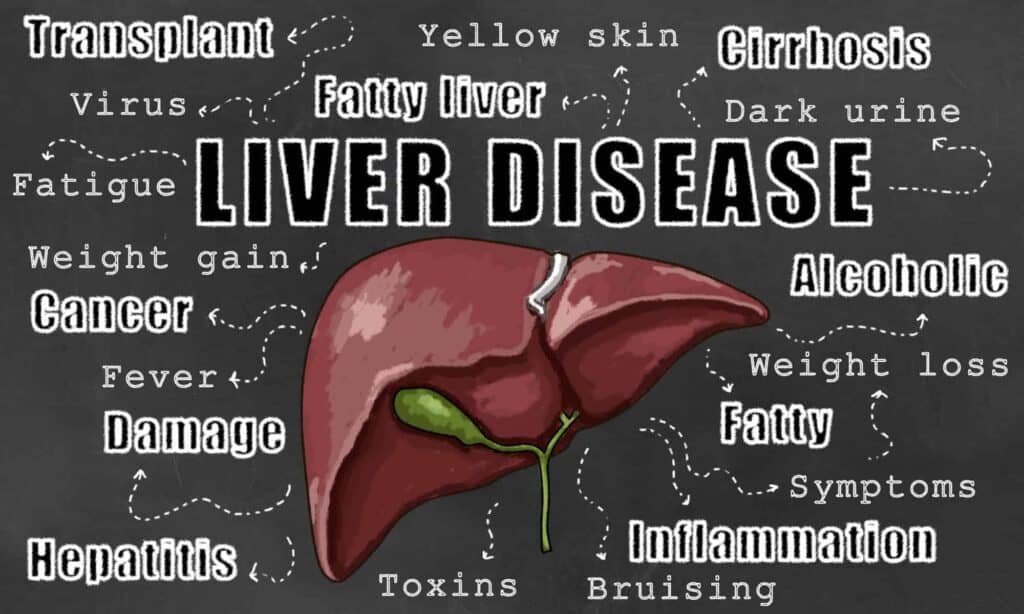
What is Non-Alcoholic Fatty Liver Disease and What Causes It?
Non-alcoholic fatty liver disease (NAFLD) is a spectrum of liver diseases that occurs when excess fat accumulates in liver cells, called hepatocytes, that is unrelated to both alcohol consumption (meaning people who consume little to no alcohol) or viral infection (like viral hepatitis).
Listed from least to most severe, NAFLD is a spectrum of liver diseases that includes:
- Steatosis
- Steatohepatitis (NASH)
- Fibrosis
- Cirrhosis
Where NAFLD is concerned, the exact disease mechanism is still unclear but insulin resistance seems to play a key role. (1) Over time, insulin receptors on all cells become less responsive, including in the liver. As a result of this, the liver goes into a mode where it increases fat storage and decreases fatty acid oxidation. Fatty deposits then form inside the liver cells, causing widespread steatosis, which is cell enlargement due to those fatty deposits. This is the first stage of liver disease.
As time goes on, the fatty deposits within the liver cells become susceptible to degradation, creating unstable fatty acid radicals that interact with the cells around them. Cell death is often the end result of these reactions, and that cell death creates inflammation of the liver. This is then termed steatohepatitis which is an inflamed fatty liver, and represents a progression into the second stage of liver disease.
Chronic Non-alcoholic Steatohepatitis, or NASH, can cause the liver cells to lay down fibrotic tissue, causing fibrosis. As fibrosis continues, the overall architecture of the liver changes, and as this process continues, the disease stage will then be classified as cirrhosis, which is the final stage of liver disease. As no one can survive without a functioning liver, cirrhosis is a life-threatening disease that typically requires a liver transplant.
NAFLD typically affects individuals with metabolic syndrome, which is another classification that involves being diagnosed with at least 3 of the following 5 risk factors:
- Obesity
- Hypertension
- Diabetes
- Hypertriglyceridemia
- Hyperlipidemia
From the late 1990s and early 2000s to the present, there has been an upward trend in the levels of obesity in the US, in both adults and children, with nearly a 40-percent rate of obesity in the adult population and nearly 20-percent in children. (2) With the rise in obesity comes a rise in metabolic syndrome and all of the correlating risk factors, and is now correlating to a rise in the incidence of NAFLD.
In the US, NAFLD is estimated to be the most common cause of chronic liver disease, affecting between 80 to 100 million people, which is nearly a third of the total population. (3) It’s a big problem that is rising right alongside the obesity rate.
What are the symptoms of Non-Alcoholic Fatty Liver Disease?
That’s a great question! One that is met with an unfortunate answer. Early signs and symptoms are often overlooked because of their apparent insignificance. Even at advanced states of steatohepatitis, there are often no symptoms or there are vague symptoms like fatigue and malaise. Basically a general ‘blah’ feeling, which can pretty much be attributed to just about anything. For this, NAFLD is often referred to as a ‘silent killer’ because people aren’t tuned into the fact that these early symptoms may be the beginning of declining liver function.
As disease progresses, people might begin to have more prominent symptoms, that are still pretty non-specific and aren’t clearly indicative of liver disease. These include:
- Nausea
- Loss of appetite
- Frequent heartburn and acid reflux
- Diarrhea or constipation
- Weight loss
- Skin itching and eczema
- Having strong reactions to common medications, like Tylenol
- Becoming inebriated with small quantities of alcohol
As the disease progresses, some troubling symptoms may finally begin to appear, like:
- Pain in the upper right abdomen
- Jaundice, a yellowing of the skin and eyes
- Easy bruising and bleeding
- Edema, fluid buildup in the legs
- Ascites, fluid buildup in the abdomen
But, these symptoms are usually indicative of significant damage. Because the liver has a very strong regenerative ability, in most people, approximately 80 to 90-percent of the liver tissue must be destroyed before liver failure manifests clinically by way of noticeable symptoms. (4) And at this stage, liver disease has more than likely progressed into various stages of cirrhosis.
For this very reason, if you have metabolic syndrome or risk factors associated with metabolic syndrome, it would be advisable that your health providers get an understanding of your current liver functioning, whether you are showing symptoms or not.
It is also important to note that a large epidemiological study of liver disease revealed that estimating the prevalence of NAFLD by blood analysis of liver enzymes consistently yielded lower estimates than studies that used imaging, like ultrasonography. As an example, a study in North America highlighted that when ultrasound was used, the incidence of NAFLD was at 24-percent as opposed to 13-percent by blood testing. (5) So getting the right testing is critical to a proper diagnosis, and should involve an abdominal ultrasound.
How Can You Reverse Non-Alcoholic Fatty Liver Disease and Support Liver Health?
So onto the good news! NAFLD is usually able to be reversed with lifestyle change, by eating a healthy diet, reducing body weight, and increasing physical activity. With very few pharmacological options available, including vitamin E, pioglitazone, and pentoxifylline, lifestyle modification and getting a firm handle on any comorbid metabolic illness is crucial for people with NAFLD. (6)
Recent studies have found that both adhering to a strict ketogenic diet or using a modified alternate-day calorie restriction strategy, a form of intermittent fasting, appear to be effective non-pharmacological interventions for helping to control the progression or reverse NAFLD. When adherence to a strict diet is very difficult, a modified intermittent fasting schedule may be a great alternative option. (7) (8)
Long-standing herbal remedies, like milk thistle and garlic, known to be liver tonics, may also play a positive role in managing NAFLD.
Like with most ailments, having the knowledge and information is the crucial first step in taking your health and longevity into your own hands. Change can be difficult, but undoing damage caused by poor lifestyle decisions is possible, and taking one step in the right direction can lead you down a path towards better health!
Sources:
- Manco M. Insulin Resistance and NAFLD: A Dangerous Liaison beyond the Genetics. Children (Basel). 2017 Aug; 4(8): 74.
- Robert Wood Johnson Foundation. National Obesity Rates & Trends. [Internet]. [cited 18th August 2019]. Available from: https://www.stateofobesity.org/obesity-rates-trends-overview/
- Perumpail B, Khan M, Yoo E, Cholankeril G, Kim D, Ahmed A. Clinical epidemiology and disease burden of nonalcoholic fatty liver disease. World J Gastroenterol. 2017 Dec 21; 23(47): 8263–8276.
- Heidelbaugh J, Bruderly M. Cirrhosis and Chronic Liver Failure: Part I. Diagnosis and Evaluation. Am Fam Physician. 2006 Sep 1;74(5):756-762.
- Younossi Z, Koenig A, Abdelatif D, Fazel Y, Henry L, Wymer M. Global epidemiology of nonalcoholic fatty liver disease—Meta‐analytic assessment of prevalence, incidence, and outcomes. AASLD Hepatology. 2016 July;64(1):73-84.
- Rinella M, Sanyal A. Management of NAFLD: a stage-based approach. Nat Rev Gastroenterol Hepatol. 24 February 2016;13:196-205.
- Vilar-Gomez E, et al. Ketogenic diet improves NAFLD, fibrosis in patients with type 2 diabetes. BMJ Open. 28 February 2019.
- Johari M, Yusoff K, Haron J, Nadarajan C, Ibrahim K, Wong M, et al. A Randomised Controlled Trial on the Effectiveness and Adherence of Modified Alternate-day Calorie Restriction in Improving Activity of Non-Alcoholic Fatty Liver Disease. Sci Rep. 2019; 9:11232.


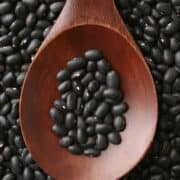

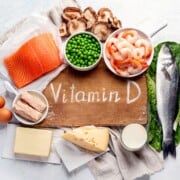
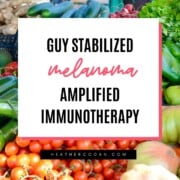


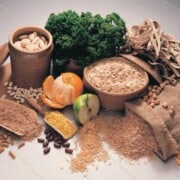










Comments
No Comments